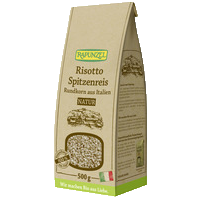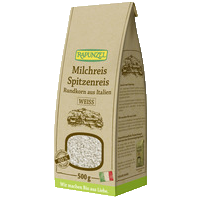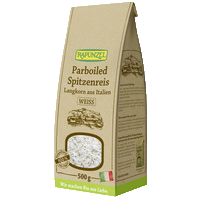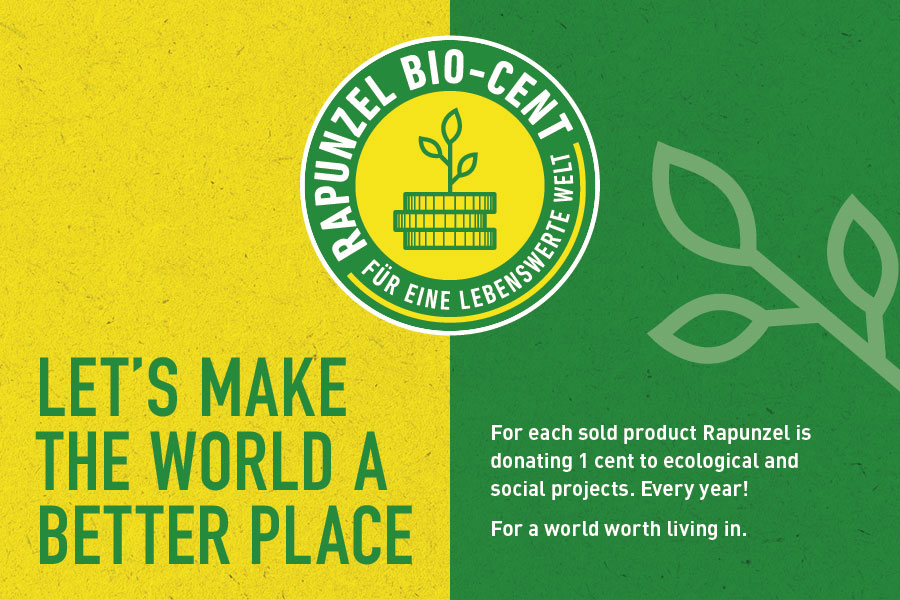Rapunzel Products Rice
Product knowledge: Rice – from brown to white and on to parboiled
Become an expert in rice qualities, cultivation and processing

Rice cultivation in the Po valley of Italy.

Rice fields in a valley in the Chiang Rai province of Thailand
Rice is the main staple of more than half of the world’s population. Rice consists of 75 percent starch. It is low in fat and contains important minerals and trace elements like phosphorus, iron and magnesium, as well as all B vitamins.
Origin, cultivation and production
There are more than one thousand varieties of rice worldwide. Since rice cultivation requires a humid climate, the biggest rice growing areas are, as you would expect, in Asia, particularly in China. But also in Southern Europe, for instance in the French Camargue region, the Po valley in Italy, and in parts of Spain, as well as in the USA, a tradition of rice growing has developed in recent decades.
Rice is a member of the sweet grass family (Poaceae). These grasses develop long panicles and wide leaves and grow to heights of up to 160 cm. There are more than one thousand varieties of rice worldwide. Cultivated rice develops up to 30 stems. Each panicle contains around 80-100 grains. This means that each seed can develop up to 3000 grains of rice. The cereal traded as wild rice is botanically speaking an aquatic grass (Zizania Aquatica) and is not part of the rice species.
Rice is a member of the sweet grass family (Poaceae). These grasses develop long panicles and wide leaves and grow to heights of up to 160 cm. There are more than one thousand varieties of rice worldwide. Cultivated rice develops up to 30 stems. Each panicle contains around 80-100 grains. This means that each seed can develop up to 3000 grains of rice. The cereal traded as wild rice is botanically speaking an aquatic grass (Zizania Aquatica) and is not part of the rice species.

Checking the rice's maturity
The different varieties found in the Rapunzel rice range include natural brown rice, white rice and parboiled rice.
Brown rice is rice in which only the husks have been removed. Unlike white rice, brown rice grains are still enclosed by the so-called silver skin and aleurone layer, while the valuable seedling is still present. These layers contain many important elements, such as vitamins, minerals, unsaturated fatty acids and dietary fibre. The nutrient content of brown rice is therefore considerably higher than that of white rice.
Due to the dietary fibre in brown rice, it satisfies hunger for longer than white rice. However, it also takes longer to cook. To produce white rice, the silver skin and the seedling are ground away from the germ of the brown rice grain. The grinding dust that this creates is removed by polishing. What is left is the starchy, fast-cooking, edible grain.
Brown rice is rice in which only the husks have been removed. Unlike white rice, brown rice grains are still enclosed by the so-called silver skin and aleurone layer, while the valuable seedling is still present. These layers contain many important elements, such as vitamins, minerals, unsaturated fatty acids and dietary fibre. The nutrient content of brown rice is therefore considerably higher than that of white rice.
Due to the dietary fibre in brown rice, it satisfies hunger for longer than white rice. However, it also takes longer to cook. To produce white rice, the silver skin and the seedling are ground away from the germ of the brown rice grain. The grinding dust that this creates is removed by polishing. What is left is the starchy, fast-cooking, edible grain.

There are more than 1,000 varieties of rice; this one is red rice from Thailand.
The so-called parboiled process was developed to preserve the important vitamins and minerals in white rice despite the removal of the silver skin and aleurone layer. The nutrients in brown rice are pressed from the outer layers of the grains into the inner layers by a combination of steam and pressure, and ‘enclosed’ within the grains. Up to 80 percent of the nutrients also remains in the white grains following polishing. Parboiled rice thus combines the benefits of a high nutrient content with a short cooking time of just under 20 minutes.
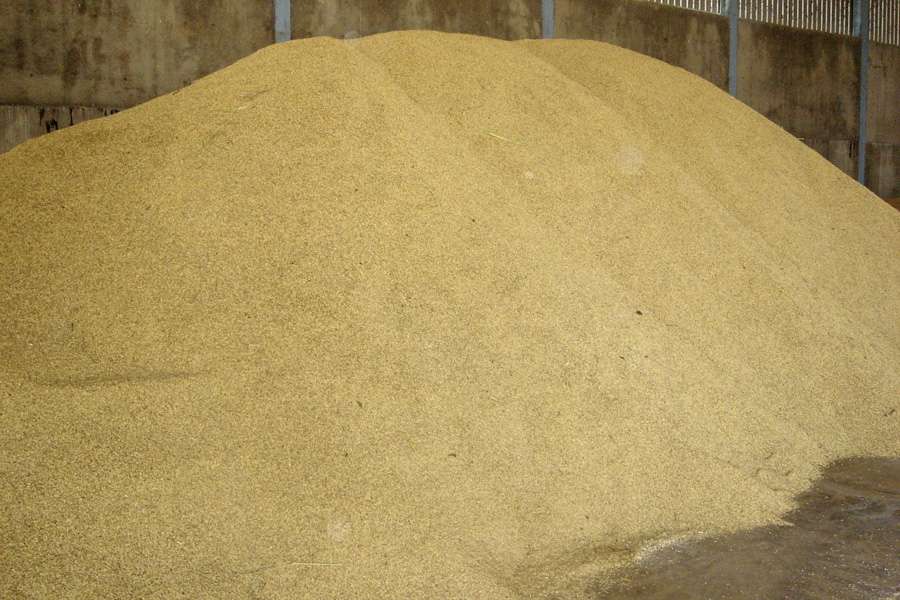
Paddy rice at the warehouse, awaiting processing
Rapunzel obtains some of its rice varieties from Asia and others from Europe. Asian varieties such as basmati or jasmine premium quality rice come from India and Thailand. European specialities, like risotto rice varieties are grown in Italy, while red Camargue premium quality rice comes from France.
Rapunzel always purchases its rice through direct import. This means that the rice varieties involved come directly from the country of origin and not through any intermediaries. This has led to intensive, years-long relationships developing with the suppliers.
When selecting its suppliers, Rapunzel pays great attention to ensuring that they continue to work with the same farmers in the long term and that they have long-term cultivation and purchasing agreements with them. Visits to suppliers and farms are undertaken regularly by the purchasing and quality assurance departments. This leads to intensive and direct exchanges on such matters as cultivation, raw product quality, and crop volumes.
Rapunzel always purchases its rice through direct import. This means that the rice varieties involved come directly from the country of origin and not through any intermediaries. This has led to intensive, years-long relationships developing with the suppliers.
When selecting its suppliers, Rapunzel pays great attention to ensuring that they continue to work with the same farmers in the long term and that they have long-term cultivation and purchasing agreements with them. Visits to suppliers and farms are undertaken regularly by the purchasing and quality assurance departments. This leads to intensive and direct exchanges on such matters as cultivation, raw product quality, and crop volumes.
Rice qualities and declarations
Rice varieties are precisely declared in accordance with the Rice Guidelines of the German Federation of Food Law and Food Science (BLL). Rice is subdivided into three classes according to the size and shape of the grains: Round grain, medium grain and long grain rice. Rice grains that are longer than 6 mm are categorised as long grain rice. Round grain rice is up to 5.2 mm in length and the ratio of its length to its width is less than 2 (i.e. the grain is no longer than twice the thickness).
The qualities are also subdivided into four categories:
- Premium rice, which contains a maximum of 5% broken grains
- Standard rice, which contains a maximum of 15% breakage
- Domestic rice, which has a maximum breakage content of 25%
- Domestic quality with a higher breakage content of up to 40% is designated as broken rice

Terraced rice fields in Thailand
Preparation and use
| Rice variety | Country of origin | Cooking time, white | Cooking time brown (whole-grain) | Use |
| Long-grain rice | Italy | 20 - 25 mins. | 40 - 45 mins. | As side dish |
| Short grain rice | Italy | 40 - 45 mins. | For risotto, rice pudding, paella, desserts, sweet casseroles | |
| Parboiled rice | Italy | 20 - 25 mins. | 25 - 30 mins. | For rapid cooking, ideal for rice salads |
| Pudding rice | Italy | 20 - 25 mins. | For rice pudding, creamy sweet dishes, and desserts | |
| Risotto short grain rice 'Ribe' | Italy | 15 - 20 mins. | 50 - 60 mins. | For risotto, paella, creamy soups, fillings |
| Carnaroli Risotto rice | Italy | ca. 20 mins. | For risotto | |
| Jasmine long-grain rice | Thailand | 40 - 45 mins. | As a side dish to curry dishes | |
| Himalayan basmati rice | India | 25 - 35 mins. | For oriental and Asian dishes | |
| Red Camargue rice | France | 40 - 50 mins. | As a side dish, ideal for rice salads and casseroles | |
| Rice combination with wild rice | Long-grain: Italy Camargue: France Wild rice: USA |
45 - 50 mins. | As a side dish with vegetable dishes, for soups, casseroles and salads | |
| Wild rice | USA | 45 - 50 mins. | As a side dish, for salads and fillings |
Creative cooking: Rice and pulses make an ideal pairing

For example, 100 g of beans can cover an adult’s daily intake of important vitamins and also contain iron, minerals and dietary fibre. Eaten together with brown rice, the beans are supplemented by polyunsaturated fatty acids, vitamins, and further minerals and fibre. The biological value of the protein contained in beans is enhanced when consumed together with rice. Biological value is a measure of how efficiently protein in food can be transformed into body protein.
You might be also interested in:
FAQ about Rice
Heavy metals such as arsenic occur naturally in our environment (air, soil, water, rocks, etc.). The rice plant absorbs arsenic through the soil and accumulates it in the grains much more than other plants. The arsenic content varies depending on the growing region.
The majority of our rice varieties come from northern Italy. There, the arsenic contamination of the soils is significantly lower than in southern Italy, for example. The arsenic levels in all our rice varieties are below the legal limits: These are 0.2 mg/kg for polished or white rice, 0.25 mg/kg for parboiled and husked rice and 0.1 mg/kg for rice used for infant formula. There is no limit for wholemeal rice. Our Basmati rice from India shows the lowest values of all Rapunzel rice varieties. Often, no arsenic is detectable here at all.
Arsenic in rice is mainly deposited in the silverskin, which is why arsenic levels are lower in white, husked rice than in whole grain rice.
The following applies to all Rapunzel rice varieties, whether whole grain or hulled, and also to our rice noodles: the heavy metal content is so low that, according to European eating habits, you could consume any of our rice varieties on a daily basis.
Background information on rice
Background information on rice
We generally recommend washing all cereals before preparation, as they are only cleaned mechanically and dust can still adhere to the cereal. With white rice, this happens when the rice grains are milled. Washing removes the dust.
mehr erfahren
mehr erfahren
The grey, sticky edge after cooking occurs with many natural cereals and brown rice. The foam that appears during cooking comes from the rice's own starch and from small particles from the shell. These particles detach from the rice grain during cooking and may then stick to the rim of the pot. This is an indication that the product is natural.
mehr erfahren
mehr erfahren
To produce white rice, the silverskin is ground off the germ of the brown rice grain. What remains is the starchy seedling, as up to 80% of the minerals and vitamins are contained in the silverskin. To avoid the loss of these minerals and still be able to peel the rice, the parboiling process is used. Using steam and pressure, the nutrients are pressed into the inside of the still unhulled grain. After hardening the surface by treating it again with hot steam, the grains are polished and the nutrients remain in the grain.
mehr erfahren
mehr erfahren



